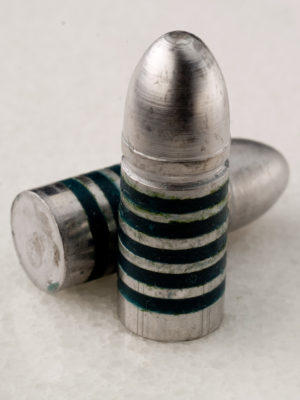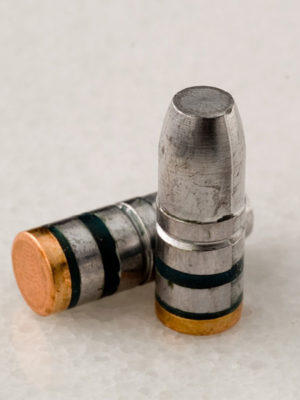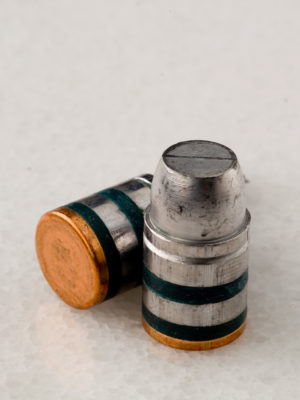How to select the right bullet for you:
Big Bore Rifle Bullets
A very large segment of the BPS shooters out there are 45 caliber fans and they’re always looking for something new to try. The 500 grain SP GC bullet is for those looking to try a more pointed projectile at those long range targets. If you’re shooting black powder or your competition rules don’t allow coated bullets we recommend the Lyman 535 grain Postell, it’s a great choice and currently our most popular bullet.
We added 44 caliber bullets as both the Sharps rifle manufacturers are chambering their rifles for this old time favorite. A good hunting bullet for this round is the RCBS 370 grain FN.
We haven’t forgotten you 40 caliber fans either. If you’re looking for a sleek long range bullet the 400 grain Snover is a great choice. Looking for something with more thump for hunting, take a look at the 405 grain LFN-GC.
Rifle Bullets
The 405 Winchester is another one of those calibers that just won’t lie down and sleep. Lyman has finally re-introduced an old classic with their 300 grain RN.
I’d been looking for a good, 32 caliber gas-checked number at about 115 grains, for a long time without success. What a great little plate puncher or small game bullet it would be in one of those 32-20 or 32 mag lever guns. I found a special order mould from RCBS that fits the bill exactly and now have it in my hot little hands. Check it out.
Pistol Bullets
More Cowboy Action shooters are placing orders with us and most of them want plain-based, soft alloy, easy to load bullets for their sport. We’ve added two such numbers; a Lyman 44 caliber 205 grain RFN and an 45 Colt Lyman 250 grain RNFP. Even if you’re not into dressing up, these will still make good, low to mid-velocity practice bullets.
Notes from Dave, Founder MBW:
In my experience with a variety of firearms, my general rules of when to shoot what, are as follows:
- Handguns
- Plain based up to 1000 fps
- Gas checked over 1000 fps and up to 1600-1800 fps
- Rifles
- HT/gas checked up to 2000 fps
- Plain based up to 1500 fps
- Big Bore
- HT/Plain based up to 1500 fps
- Gas checked maybe up to 2000 fps
You’ll know you’ve gone too far when leading and/or inaccuracy starts to occur. Other shooters may be able to attain different results depending on all kinds of factors; rate of fire, heat of the day, powder used, etc, but these are my general rules.
- LFN – Long nose profile ballistically better for shooting long range (over 100 yds) – excellent hunting bullet
- WFN – Large wound channel, but not a long range bullet (less than 100 yds) – excellent hunting bullet
- HT – Alloy is a better alloy for hunting because high antimony alloys like linotype tend to be brittle and shatter when they hit hard bone.
You get a better gas seal and better accuracy with a bullet sized .001″ over the groove size in rifles. In revolvers, you get a better gas seal and better accuracy with a bullet sized equal to the cylinder throat diameter.
Cowboy Silhouette
For you Cowboy Silhouette lever gun shooters, the RCBS 100 grain FN-GC in both HTW and Linotype will be a great bullet for the 25-35. For reduced hunting or target loads, it will also work well in the 25 caliber center fire rifles. If you really want to practice with your center fire rifles and you’re not shooting cast bullets, you’re missing out on a fun and inexpensive activity. It’s also a great way to move young or recoil sensitive shooters into center fire cartridges.
I and others have used the 357 magnum in lever guns for the Cowboy Silhouette matches with great results. The 180 grain bullets work particularly well. Just in case you want to load them to velocities that are greater than HTW can tolerate without leading, I offer the Saeco 180 SIL-GC and the RCBS 180 SIL-GC in Linotype.
For the 30 caliber crowd, the Lyman 210 grain RN-GC in both HTW and Linotype is a great bullet to try. This is the bullet weight for the 30 Government and 30-40 Krag. It can also be used in virtually any 30 caliber rifle for target shooting or hunting.
If you like big bores and big bullets as much as I do, then you know that to become proficient, you must practice, practice, practice. But feeding these brutes with factory ammo, or even jacketed bullet hand loads, can strain the shooting budget. Cast bullets are the answer to inexpensive and easy on the shoulder fodder. So if you own a 416 Rigby, Remington or 416 wildcat, cast bullets in HT and Linotype are something you will want to try. Cast bullet hand loads will also allow you to use these buffalo busters for the more ordinary task of taking your annual deer, moose, etc.
If you like to hunt the big stuff with your six shooters, the 45 caliber 325 grain WFN design in both plain base and gas checked designs or the LBT 320 LFN-GC are all excellent choices.
The Lyman 50 caliber 340 grain FN was designed for the 50-110 Black Powder Express but can be used in any 50 caliber rifle. It is available in both HTW and Linotype. The alloy you select will depend upon your velocity/pressure intentions.
Overbore 44
A customer of mine was describing problems he was having with his new Marlin 1894 Cowboy II in 44 mag. Seems that when the bullets hit the target (seldom), there were clear signs of tumbling. Curious. A call to Marlin informed him that they are using .432″ bores to reduce pressure! Friends, that model will never shoot a typical .429-.430″ bullet accurately. It just so happens that I had a similar problem years ago with a Remington Model 788 in 44 mag and had two custom moulds cut. Problem solved. My customer tells me the rifle now shoots “one ragged hole”. These two NEI moulds, a 230 grain SWC-GC and a 240 grain SWC-GC, are made to size out at .433″ and turned both of these guns into respectable shooters. Do you have an overbore 44?
Some knowledgeable Ruger handgun shooters have informed me that their (all?) Ruger 44’s suffer from large cylinder throats. Instead of the .429-.430″ throats that you might expect, their guns run up to .432″. If you visit the FAQ section entitled, “How do I determine what size my bullets should be?”, you’ll understand that these guns need an appropriately sized bullet to shoot up to their potential. Therefore, for those of you who share this problem, we’ve added diameter range information on all our bullets, to the price lists. Now let’s see what your 44 can do with the right sized bullets!
Got a young shooter you want to introduce to big game rifles? Why not drag out “Old Reliable” and ease your student into the big stuff with reduced velocity cast bullet handloads? Try the RCBS 270 caliber 150 grain SP-GC. It is offered in both HTW and Linotype.
The WFN series is an excellent hunting bullet for close to medium range applications and delivers tremendous shock. In my experience, the LFN design is ballistically superior for shots that exceed 100 yards or so. Either way, you owe it to your handgun to try some of both. The gas checked designs in HTW can be shot up to 1600 fps while the plain based bullets should be limited to around 1200 fps to avoid leading. Check out all your options in 45, 44, 41, 357, 475 and 500 caliber, in the WFN designs, both in gas checked and plain based guises.
Most of my bullets are cast from a Lyman No. 2 alloy (BHN of 15) except paper patched, which are soft lead (BHN of 6). You can easily shoot all of these bullets to 1500 fps without problem. Most of the pistol bullets and select rifle bullets are made with our Heat Treated Wheel Weight (HTW) alloy. With a BHN near that of linotype (BHN of 22), they can be driven nearly as fast but cost less.
Bullets cast from linotype (L) have a BHN of 22 and can be shot to 2300+ fps without leading. If you intend to shoot any cast bullet much above 1500 fps, only linotype or heat treated wheel weight (HTW) alloy will do. Discuss your needs with us and we will provide you with bullets of the correct alloy. Please note that linotype is a more expensive alloy and prices reflect that.
You can read first hand how Clint Smith of Thunder Ranch in Oregon uses some of our 44 Mag 265 grain bullets. Get the May, 2006, copy ofGuns magazine and turn to page 26. His article is titled “Brick Slingers”.
Again, we’ve had the privilege of having our bullets featured in a prestigious magazine. Mike Venturino’s article “Non-Magnum .41 Magnum Loads” in the August-September, 2006, issue of Handloader magazine talks about our 200 grain WFN and 220 grain TRN-GC bullets.
Read what Brian Pearce has to say about some our bullets in the April, 2009,
issue of Handloader magazine, page 89 and 90.
And again, Brian shoots some of our bullets in a Ruger New Model Blackhawk .44 Special and talks about them in the June, 2009, issue ofHandloader magazine. His article begins on page 32.
In the February, 2010, article “The Middle Ground 45 ACP 200-Grain Performance Loads”, Brian reviews and compares our bullets to other makers and he offers our name a source for high-quality, hand-cast Keith bullets for the .44 Magnum.
Notes from Dave, Founder MBW:
In my experience with a variety of firearms, my general rules of when to shoot what, are as follows:
- Handguns
- Plain based up to 1000 fps
- Gas checked over 1000 fps and up to 1600-1800 fps
- Rifles
- HT/gas checked up to 1800 fps
- Linotype/gas checked up to 2300 fps
- Plain based up to 1500 fps
- Big Bore
- HT/Plain based up to 1500 fps
- Gas checked maybe up to 1800 fps
You’ll know you’ve gone too far when leading and/or inaccuracy starts to occur. Other shooters may be able to attain different results depending on all kinds of factors; rate of fire, heat of the day, powder used, etc, but these are my general rules.
- LFN – Long nose profile ballistically better for shooting long range (over 100 yds) – excellent hunting bullet
- WFN – Large wound channel, but not a long range bullet (less than 100 yds) – excellent hunting bullet
- HT – Alloy is a better alloy for hunting because high antimony alloys like linotype tend to be brittle and shatter when they hit hard bone.
You get a better gas seal and better accuracy with a bullet sized .001″ over the groove size in rifles. In revolvers, you get a better gas seal and better accuracy with a bullet sized equal to the cylinder throat diameter.
Cowboy Silhouette
For you Cowboy Silhouette lever gun shooters, the RCBS 100 grain FN-GC in both HTW and Linotype will be a great bullet for the 25-35. For reduced hunting or target loads, it will also work well in the 25 caliber center fire rifles. If you really want to practice with your center fire rifles and you’re not shooting cast bullets, you’re missing out on a fun and inexpensive activity. It’s also a great way to move young or recoil sensitive shooters into center fire cartridges.
I and others have used the 357 magnum in lever guns for the Cowboy Silhouette matches with great results. The 180 grain bullets work particularly well. Just in case you want to load them to velocities that are greater than HTW can tolerate without leading, I offer the Saeco 180 SIL-GC and the RCBS 180 SIL-GC in Linotype.
For the 30 caliber crowd, the Lyman 210 grain RN-GC in both HTW and Linotype is a great bullet to try. This is the bullet weight for the 30 Government and 30-40 Krag. It can also be used in virtually any 30 caliber rifle for target shooting or hunting.
If you like big bores and big bullets as much as I do, then you know that to become proficient, you must practice, practice, practice. But feeding these brutes with factory ammo, or even jacketed bullet hand loads, can strain the shooting budget. Cast bullets are the answer to inexpensive and easy on the shoulder fodder. So if you own a 416 Rigby, Remington or 416 wildcat, cast bullets in HT and Linotype are something you will want to try. Cast bullet hand loads will also allow you to use these buffalo busters for the more ordinary task of taking your annual deer, moose, etc.
If you like to hunt the big stuff with your six shooters, the 45 caliber 325 grain WFN design in both plain base and gas checked designs or the LBT 320 LFN-GC are all excellent choices.
The Lyman 50 caliber 340 grain FN was designed for the 50-110 Black Powder Express but can be used in any 50 caliber rifle. It is available in both HTW and Linotype. The alloy you select will depend upon your velocity/pressure intentions.
Overbore 44
A customer of mine was describing problems he was having with his new Marlin 1894 Cowboy II in 44 mag. Seems that when the bullets hit the target (seldom), there were clear signs of tumbling. Curious. A call to Marlin informed him that they are using .432″ bores to reduce pressure! Friends, that model will never shoot a typical .429-.430″ bullet accurately. It just so happens that I had a similar problem years ago with a Remington Model 788 in 44 mag and had two custom moulds cut. Problem solved. My customer tells me the rifle now shoots “one ragged hole”. These two NEI moulds, a 230 grain SWC-GC and a 240 grain SWC-GC, are made to size out at .433″ and turned both of these guns into respectable shooters. Do you have an overbore 44?
Some knowledgeable Ruger handgun shooters have informed me that their (all?) Ruger 44’s suffer from large cylinder throats. Instead of the .429-.430″ throats that you might expect, their guns run up to .432″. If you visit the FAQ section entitled, “How do I determine what size my bullets should be?”, you’ll understand that these guns need an appropriately sized bullet to shoot up to their potential. Therefore, for those of you who share this problem, we’ve added diameter range information on all our bullets, to the price lists. Now let’s see what your 44 can do with the right sized bullets!
Got a young shooter you want to introduce to big game rifles? Why not drag out “Old Reliable” and ease your student into the big stuff with reduced velocity cast bullet handloads? Try the RCBS 270 caliber 150 grain SP-GC. It is offered in both HTW and Linotype.
The WFN series is an excellent hunting bullet for close to medium range applications and delivers tremendous shock. In my experience, the LFN design is ballistically superior for shots that exceed 100 yards or so. Either way, you owe it to your handgun to try some of both. The gas checked designs in HTW can be shot up to 1600 fps while the plain based bullets should be limited to around 1200 fps to avoid leading. Check out all your options in 45, 44, 41, 357, 475 and 500 caliber, in the WFN designs, both in gas checked and plain based guises.
Most of my bullets are cast from a Lyman No. 2 alloy (BHN of 15) except paper patched, which are soft lead (BHN of 6). You can easily shoot all of these bullets to 1500 fps without problem. Most of the pistol bullets and select rifle bullets are made with our Heat Treated Wheel Weight (HTW) alloy. With a BHN near that of linotype (BHN of 22), they can be driven nearly as fast but cost less.
Bullets cast from linotype (L) have a BHN of 22 and can be shot to 2300+ fps without leading. If you intend to shoot any cast bullet much above 1500 fps, only linotype or heat treated wheel weight (HTW) alloy will do. Discuss your needs with us and we will provide you with bullets of the correct alloy. Please note that linotype is a more expensive alloy and prices reflect that.
You can read first hand how Clint Smith of Thunder Ranch in Oregon uses some of our 44 Mag 265 grain bullets. Get the May, 2006, copy ofGuns magazine and turn to page 26. His article is titled “Brick Slingers”.
Again, we’ve had the privilege of having our bullets featured in a prestigious magazine. Mike Venturino’s article “Non-Magnum .41 Magnum Loads” in the August-September, 2006, issue of Handloader magazine talks about our 200 grain WFN and 220 grain TRN-GC bullets.
Read what Brian Pearce has to say about some our bullets in the April, 2009,
issue of Handloader magazine, page 89 and 90.
And again, Brian shoots some of our bullets in a Ruger New Model Blackhawk .44 Special and talks about them in the June, 2009, issue ofHandloader magazine. His article begins on page 32.
In the February, 2010, article “The Middle Ground 45 ACP 200-Grain Performance Loads”, Brian reviews and compares our bullets to other makers and he offers our name a source for high-quality, hand-cast Keith bullets for the .44 Magnum.


